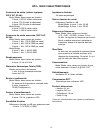
DPC 1400X. The binding posts of each channel are wired in parallel with that channel’s 1/4"
outputs. This allows for parallel speaker systems. The minimum impedance in stereo mode is 2
ohms. Use of the amplifier below the minimum 2 ohm rating could result in overheating and thermal
shutdown. In bridge mode connect the banana plug of your speaker cable to the red binding posts
of channels A and B. The red binding post of channel A is the positive output terminal and the
minimum load impedance is increased to 4 ohms while in bridge mode. (Bridge mode is explained
in more detail later in this manual.)
PARALLEL 1/4" SPEAKER OUTPUTS (11)
Two parallel 1/4" speaker output jacks are provided for each channel of the DPC 1400X.
When adding speakers in parallel always keep in mind your total speaker impedance,
insuring that it does not drop below the minimum load impedance rating of the DPC 1400X.
FUSE (12)
The fuse is located in the cap of the fuse holder. If the fuse should fail, IT MUST BE
REPLACED WITH THE SAME TYPE AND VALUE IN ORDER TO AVOID DAMAGE TO TO
EQUIPMENT AND TO PREVENT VOIDING THE WARRANTY. If the amp repeatedly blows
fuses, it should be taken to a qualified service center for repair.
WARNING: THE FUSE SHOULD ONLY BE REPLACED WHEN THE POWER CORD HAS
BEEN DISCONNECTED FROM ITS POWER SOURCE.
AC LINE CORD SOCKET (13)
Provided to accept the removable (IEC) type AC line cord. Connect only to proper source (see back
panel markings.)
INSTALLATION AND CONNECTION
The DPC professional series of power amplifiers is designed for durability in commercial installations
and has the quality of performance required in studio. These units are a standard rack-mount config-
uration height, and each is cooled by a variable-speed internal fan. All input and output connections
are on the back panel. Additionally, the level controls and selector switches are on the front panel.
The front panel also contains LED indicators for power and DDT activation, and the mains power
switch.
INDUSTRIAL AND COMMERCIAL INSTALLATIONS
For commercial and other installations where sustained high power operation is required, the
amplifiers should be mounted in a standard 19" rack. It is not necessary to leave a rack space
between each amplifier in the stack since each fan pulls air in from the rear and exhausts the hot air
out the front. However, an adequate cool air supply must be provided for the amplifier when rack-
mounted. The internal fan must have a source of air that is not preheated by other equipment. If
cool, the amplifier will start up in low speed fan operation and will normally stay at low speed
operation unless sustained high power operating levels occur. Then, as the amplifier heat sinks heat
up, the automatic thermal sensing circuitry will increase the fan speed. Depending upon signal
conditions and amp loading, the fan speed may increase to a maximum value, or it may decrease to
a minimum value. This situation is quite normal. If cooling is inadequate due to preheated air or a
reduction of air flow occurs due to blockage of the amplifier inlet/outlet ports, or if the amplifier is
severely overloaded or short circuited, the amplifier thermal sensing system may cause temporary
shutdown of the unit. This is indicated by the status LEDs on the front panel illuminating red.
Depending upon the available cooling air, operation should be restored relatively quickly, and the
5


















